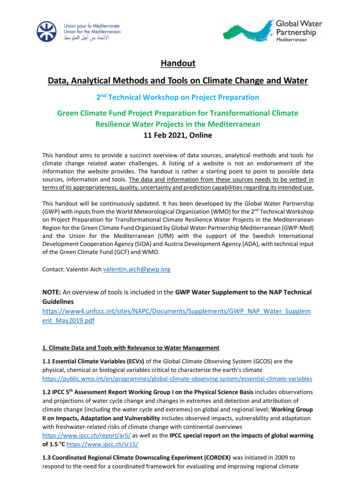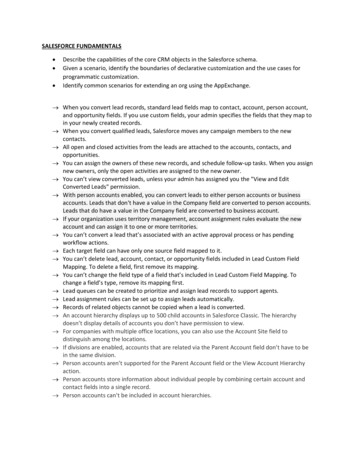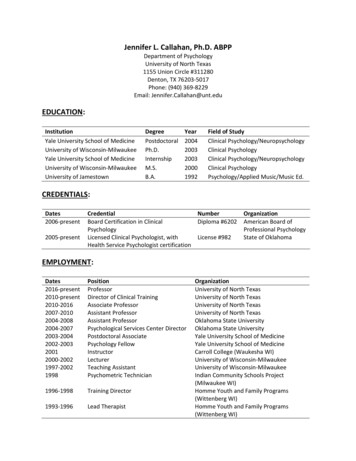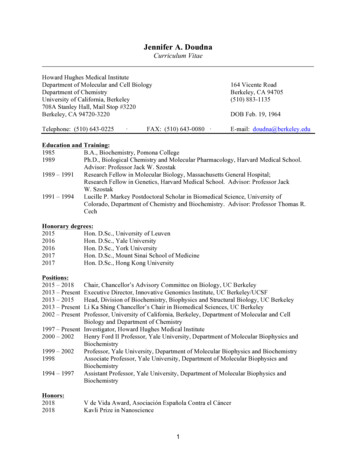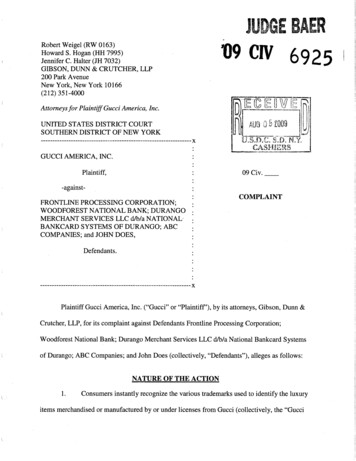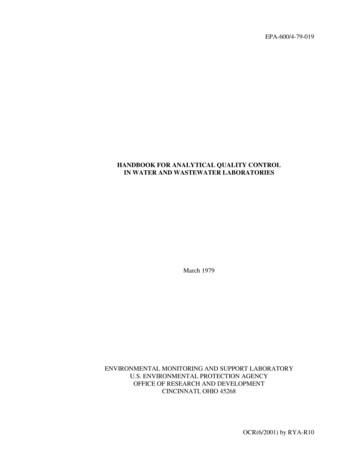
Transcription
1Analytical ToolsAnalytical ToolsJennifer DillyFerris State UniversityNovember 20, 2011
2Analytical ToolsLawson Enterprise Performance Management SoftwareOverviewLawson provides multiple software options including clinical software, managementsoftware for finance, human resources, manufacturing, and supply chain, as well as an overallBusiness Intelligence software line called Enterprise Performance Management. The provision ofsoftware with the ability to combine various pieces of data throughout the business is the visionof Lawson. The Enterprise Performance Management is broken down into different applicationsand tools that provide data collection and storage along with analysis capabilities to provide anincrease in organizational performance. Lawson’s applications are usable with their BusinessProcess Platform called the Business Process Management suite and a middleware, SystemFoundation, both powered by IBM. The Process Management suite provides a workflow tool toautomate various processes within the software, as well as a configuration tool and XML-basedweb services.The ToolsBusiness IntelligenceLawson’s Business Intelligence technology analyzes data and provides views oforganization-wide performance through dashboards, scorecards, and graphs. Data regardingfinances, customers, organizational processes and human resources is drawn directly fromLawson as well as other systems. Lawson boasts highly detailed reports including the ability todrill down to the transaction level. Demos are provided by the company using these bi-demo-m3Business Performance WarehouseThe Performance Warehouse product builds the data warehouse for the businessintelligence tools and implements extraction, transformation and load (ETL). The data comesfrom Lawson and other systems and includes multiple data types. The highlight of this productincludes the capability of managing information efficiently and in-expensively.Opportunity AnalyzerThe Opportunity Analyzer is a decision support tool enabling business leaders to settargets for achievements in various objectives including financial growth. The tool’s intent is to
3Analytical Toolshelp identify and prioritize initiatives that will help management implement best practices andachieve efficiency ultimately leading to increased opportunities in financial improvement.S3 Add-insThe Lawson S3 add-ins allow for ease of data access from Microsoft Office Excel andWord documents for the creation of various reports. Users can opt to use Lawson’s pre-definedreports using XML, PDF, TXT, CSV, or Crystal formats.M3 AnalyticsThe M3 Analytics are used for management of sales, finance, and supply monitoring.These tools provide performance reports related to various key performance indicators. Thereare specific Analytics for Food and Beverage and Manufacturing both with individualperformance indicators drilling down to supplier, products and customers.Healthcare AnalyticsLawson’s Healthcare Analytics allows facilities to pull clinical and financial data intandem for organizational decision-making. Data from supply chain, human resources, finance,and clinical systems can be obtained helping management monitor overall cost savings whileallowing for an increased focus on quality care. Implementation of this tool can be done in a fewweeks as compared to other tools that could take a considerable length of time.Staff TrainingLawson provides multiple ways to learn including hands-on training with instructors,online learning including a Learning Suite, workshops, and another type of software, theLearning Accelerator, which allows the organization to create personalized learning programsand simulations. The training consists of the general overview of the software, the applicationand technical training for implementing the solutions, user training specific to the organization’susage of the product, as well as some advanced training for more of the features of the product.Maintenance and SupportTwo types of maintenance plans are given as options. Both cover product updates andupgrades, assistance via email and telephone, including a timeframe (one hour) for response, andtracking of issues addressed. The higher level maintenance plan also includes a few more supportservices such as an appointed account manager and planning assistance for installation updates.Online support is available for facilities with a service agreement and who have already receivedtraining. There is also help available for those who require help with installation.
4Analytical ToolsSAS Analytics SoftwareOverviewSAS Incorporated has many software options available to be used in a wide range ofindustries from casinos, to healthcare facilities, to transportation. Each industry has its’ ownneeds and SAS provides software that covers many of those needs for business intelligence,analytics, and various types of management. The SAS Analytics software includes data miningand analysis, multiple graphics for viewing of data analysis, forecasting, workflow managementand modeling, project managing, and monitoring of improvements with statistical analysis. Thegoal of this software is to provide businesses with an overall view of performance to reveal newprocesses for future improvements.The ToolsPredictive Analytics and Data MiningThe components of SAS Analytics include data mining on the users’ desktop through useof JMP Pro software combined with SAS analytics. SAS’s Enterprise Miner is a graphicalinterface that creates the modeling and is capable of processing large amounts of data. Interfacecapabilities include use with Microsoft Excel.Figure 1 – Side by Side ModelingData VisualizationSAS Visual Data Discovery provides the visualization of the data. Graphs andpresentation of the data is interactive and allows the user to insert animations or even provide 3dimensional views of the data. An unlimited amount of data can be used and inserted when
Analytical Tools5needed. Figure 2 gives an example of use of multiple data variables perhaps from research orsurveys.Figure 2 – Multiple Variables UsedForecastingThere are two components to SAS’s Forecasting Software, the SAS/ETS software and theForecast Server. These components provide forecasting for various processes over varyingtimeframes. SAS has the ability to access other databases from the government and commercialvendors as well as from some international data. The forecasts can include large amounts of dataand can include multiple variables such as holidays, certain events, promotions, etc. Figure 3includes an example of the forecasting capabilities.Figure 3 – SAS Forecasting
Analytical Tools6Model Management and MonitoringSAS has a Model Manager which produces predictive analytical models. The models canbe customized to the organization’s needs, including regulatory agency compliance, andmonitoring of effectiveness can be done in real-time. Figure 4 is an example of the ModelManager, while Figure 5 shows the capability of tracking progress of multiple projects throughthe use of a dashboard.Figure 4 – Model ManagerFigure 5– Tracking Multiple ProjectsQuality ImprovementSAS/QC software provides monitoring of processes for overall improvement. Thesoftware can pull multiple types and large amounts of data thought to help identify the true root
Analytical Tools7cause of process issues. This is accomplished through use of statistical process control charts,histograms, Pareto charts and others. Figure 6 shows an example of one such chart.Figure 6 – Pareto chartStatisticsThe statistics software from SAS has two components, Interactive Matrix Programming(IML) and Statistical Analysis. IML includes a SAS/IML Studio interface which allowsmathematical formulas to be translated in to programming statements and ultimately interfacewith the SAS/IML software to graph and view the data (see Figure 7). The data analysis iscompletely customizable, the user can decide what data to include and exclude within graphs andmodels.Figure 7 – SAS/IML Studio ExampleThe Statistical Analysis component includes SAS/STAT software. This software isrequired for many of the other software suites to run as it provides many different types
Analytical Tools8statistical analysis for the user to choose (Figure 8). Many different types of graphics are alsocreated. Only Base SAS is required for this software and it will run on multiple platforms.Figure 8 – Choosing the AnalysisText AnalyticsSAS Text Analytics has four components, Enterprise Content Categorization (withoptional add-ons), Ontology management, Sentiment analysis, and unstructured text mining. TheEnterprise content captures key phrases within text while the Ontology management softwarecaptures text that would not necessarily mean anything unless there has been clear definition ofthe semantics within the data. This allows data from documents that may not have thought to berelated to be linked. Sentiment analysis allows capture of opinions or customer sentiments frommultiple formats. The Text mining component extracts, transforms, and loads data for miningand can present it either at a high overview level or in greater detail. Figure 9 shows how tosearch within the Text mining software.Figure 9 – Filtered Searching
9Analytical ToolsStaff TrainingTraining for the various software products is broken down into job roles. For example,those who would need training on the Business Intelligence software may include ProjectManagers, or Business Intelligence Content or Application Developers. There are various typesof training available including classroom setting, live web classroom and online learning.Training is broken down in to four different levels, from beginner all the way to expert. Thereare also opportunities for an instructor to provide on-site training or even private mentoring.Maintenance and SupportSystem administrators at individual facilities provide the software installation, updates,and hot fixes as part of the maintenance for the software. If there are any issues and neededmaintenance, SAS sends the system administrators the maintenance releases for application.There are multiple resources listed for support either online or via phone. Problems can besubmitted, updated, and tracked for resolution. There is even a resource provided to check onlicensing details or troubleshooting.ComparisonThe table below contains highlights of both company’s software. The numbers representhow helpful each highlight would be to this specific organization, with a 3 being most helpful.TraitsComprehensive Data (ability to pull across tware and other vendors)Text Data CapturingCustomizable ReportsDrill Down le Pieces of Software NeededUser SupportOverall CostPlatformBoth companies provide similar abilities to pull data across their own different softwarepieces as well from non-Lawson or non-SAS software, but SAS seemed to have better capabilityfor reliably capturing text data. The reporting capability of both would suffice; however, SAShas slightly better reporting capabilities to fit the organization’s needs for customizable, “highlevel” and “drill down” types of reports. Both companies provided some level of maintenance
Analytical Tools10with Lawson providing two different types of plans, while SAS seemed to rely on theorganization’s system administrators to apply upgrades, etc. SAS provides a way fororganizations to report issues and track them for resolution and both companies provide differentlevels of user support. The overall cost of Lawson may be cheaper, however dependent uponhow much an organization requires or needs, SAS offers many parts and pieces of valuablesoftware that can be stand-alone (does not require other software to run). SAS is able to run onvarying platforms while Lawson runs on IBM.
11Analytical ToolsReferencesHavenstein, H. (April 3, 2006). SAS touts its integration, storage tools for BI projects.Computerworld. Retrieved SAS Touts Its Integration Storage Tools for BI ProjectsHowson, C. (November 2005). Beyond statistics: SAS takes on mainstream BI. Retrieved retrieve.do?sgHitCountType None&sort DASORT&inPS true&prodId CDB&userGroupName lom ferrissu&tabID T003&searchId R1&resultListType RESULT LIST&contentSegment &searchType AdvancedSearchForm¤tPosition 12&contentSet GALE A139038342&&docId GALE A139038342&docType GALE&role Lawson (2011). Enterprise Performance Management. Retrieved prise-Performance-Management/Lawson Software releases new version of Lawson Talent Management Suite. WorldwideComputer Products News 19 Feb. 2010. Computer Database. Web. 14 Nov. 2011.Document URL ?id GALE%7CA219327193&v 2.1&u lom ferrissu&it r&p CDB&sw wSAS (2011). SAS Analytics. Retrieved from http://www.sas.com/technologies/analytics/
Business Intelligence Lawson’s Business Intelligence technology analyzes data and provides views of organization-wide performance through dashboards, scorecards, and graphs. Data regarding finances, customers, organizational processes and human resources is drawn directly from Lawson
